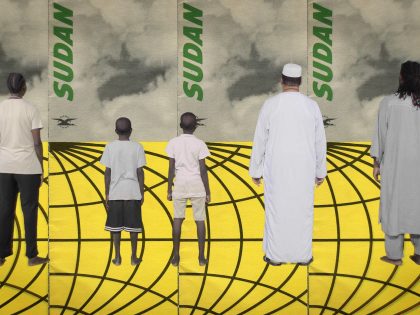Drones in Somalia
The US, which has misread the political situation in Somalia before, is again pursuing short-term military gains there at the risk of long-term blowback.

Stuart Price (via AMISOM Flickr CC).
American military involvement in Somalia is increasing. Jeremy Scahill of The Nation reports that the US recently conducted as many as four drone strikes on targets linked to al Shabab, the rebel movement that controls much of southern Somalia. Scahill has, moreover, revealed the existence of a CIA base in the capital Mogadishu, where American operatives train Somali intelligence agents and reportedly participate in interrogations of suspects accused of being terrorists. American officials seem to believe that such involvement is necessary in order to weaken and contain Somalia-based terrorists. Confidence that warfare is changing – in other words, costing the US fewer casualties – appears to encourage the gamble that a light American presence will have minimal political repercussions. Yet Washington, which has misread the political situation in Somalia before, may once again be pursuing short-term military gains at the risk of long-term blowback, both in Somalia and at home.
Direct and indirect American participation in Somalia’s civil war is not new. Following the collapse of Siad Barre’s regime in 1991, US troops deployed as part of the United Nations Operation in Somalia. When a mission to capture a warlord went wrong in the “Black Hawk Down” incident of 1993, nineteen American soldiers died, and US forces exited Somalia. In late 2006, concerned about the rise of the Islamic Courts Union (ICU), a movement reputed to have terrorist ties, Washington backed an Ethiopian occupation that lasted until early 2009. The fall and fragmentation of the ICU, combined with the brutality of the Ethiopian occupation, facilitated the rise of al Shabab, the ICU’s military wing. Washington has designated al Shabab a terrorist organization (the group has proclaimed ties to al Qaeda), and seeks to deny the movement a base for international terrorist operations. Ethiopia’s withdrawal initiated the latest phase in the civil war, but did not end US involvement. In 2009, a US helicopter raid killed Saleh Ali Saleh Nabhan, a Kenyan-born al Qaeda operative who was working with al Shabab. In addition to military involvement directly or by proxy, the US has over the years provided support to various would-be governments, including the Transitional Federal Government (TFG), which is currently battling al Shabab for control of southern Somalia.
The drone strikes and the CIA presence form part of this history of American intervention. As before, the current strikes could give a political boost to al Shabab. Former Ambassador David Shinn recently told Congress that some previous US military strikes “have resulted in collateral damage and others, according to accounts from many Somalis, have generated sympathy and even served as a recruitment tool for al-Shabaab.” Shinn recommends limiting strikes to high-value targets, and cautions that the risks of expanding strikes outweigh the benefits of killing significant, but easily replaced, commanders.
The fight between the TFG and al Shabab has also increasingly affected East Africa and distorted American relations with the whole region. In addition to precipitating the Ethiopian occupation, Somalia’s crisis has spilled into Kenya as refugees flood in and fears grow that Kenyan-Somali youth are joining al Shabab. Uganda and Burundi are the major suppliers of troops to the African Union Mission in Somalia (AMISOM), the force that has been instrumental in the TFG’s meager gains against al Shabab in Mogadishu. Uganda became a target of al Shabab when suicide bombers struck the capital Kampala in July 2010.
The roles of Ethiopia, Kenya, and Uganda in fighting al Shabab have confronted the US, which considers all three countries allies, with ugly trade-offs. The imperative of fighting terror coexists uneasily with stated US agendas of democratic reform, a concern in dealing with Ethiopia and Uganda, whose democratic credentials are questionable, as well as with Kenya, whose 2007-2008 electoral violence may foreshadow a bloody sequel in 2012. When the US attempts to influence the course of events in Somalia militarily, it not only participates in Somali politics, it compromises on core values throughout the region.
American political involvement in Somalia also risks causing political blowback within the Somali-American community. Ties are tight between Somalia and its diaspora. What happens there matters abroad. Arrests of Somalis in the US on charges of plotting or aiding terrorist operations suggest that a significant minority of the Somali-American community sympathizes with al Shabab. Several American citizens have died fighting for al Shabab already. The Ethiopian invasion of Somalia increased anger at Washington within the diaspora, and more American involvement in Somalia could stoke that anger. In the worst case scenario, an angry Somali-American might conduct a successful terrorist operation within the US.
The two trends signaling deepening military involvement in Somalia – drone strikes and the CIA presence – are the same trends taking place in American military operations around the world, and they are the same trends that nurture the belief that the human and political costs of warfare are decreasing for the US.
Costs are indeed decreasing to the extent that there is less risk now of American casualties in Somalia than there would be if troops deployed there. Moreover, the militarization of the CIA has, in Libya and Pakistan as in Somalia, allowed Washington to say it has no “boots on the ground,” and thereby reduce domestic outcry concerning risks to US personnel.
But politics don’t end at the water’s edge. As happened in Pakistan with the case of Raymond Davis, a CIA operative who came to worldwide attention when he shot two Pakistanis and was subsequently imprisoned, a disaster involving even one American official abroad can quickly become a political problem for Washington. And if Americans pay less attention to drone strikes overseas than they do to deployments, that is not the case for communities where strikes fall. If America’s indirect involvement was known and resented when Ethiopia invaded Somalia, its direct involvement through drone strikes will likely be known and resented as well. The Ethiopian invasion was the crucible in which today’s al Shabab was, despite American intentions of neutralizing Somali Islamism, formed. The political outcome of present American military involvement in Somalia could be equally unpleasant.
- Merci to Islam and Arabic Studies Jacob Mundy for the connect.



















